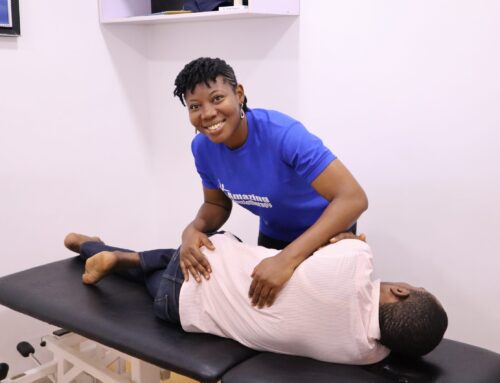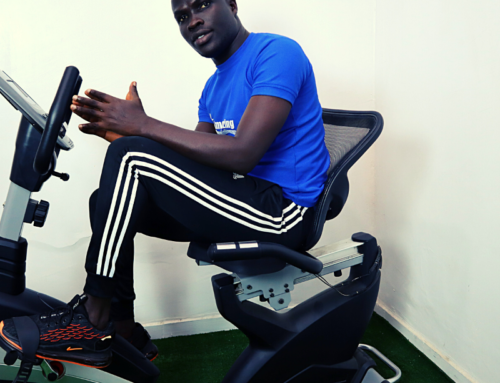It is no doubt a new dawn for most of us, when we turn 40.
it is judged one of the most exhilarating stages of life, to some it is with mixed feelings. We also remember the saying that a fool at 40 is a fool forever.
Why does it seem like our health more often than not begins to fail us once we get to our 40th birthday, from low back pain, to high risk of hypertension and diabetes, heart related diseases just to mention a few.
Could it be physiological or spiritual?
fig from Sandra Kinslow
Few days back a very good friend of mine just turned 40 years old. We celebrated his birthday with a lot of Aura and glamour. It was like celebrating Christmas in August.
One week later just like every other day he bent to pick up his 2 years old son running to embrace him as he always does, unfortunately, for him, his son has put up more pounds. On attempt to lift him he felt a sharp pain in the back, from then on, bending, turning and even walking became a problem. His wife emphasized he needed to walk taller and straight, she complained he bends to one side. But because he was only comfortable bending to that side, it left him with an asymmetrical posture, in his own words “he became disfigured.
Why does our health suddenly start failing as we age?
It all boils down to how we took our healthy habits seriously when we were younger.
We have shocking statistics of rise in non-communicable disease and people at risk of disability, death and other complex health conditions all due to our lifestyle.
How physically active are you?

How often do you put on your snickers and take a walk or park your car in the parking lot and take a walk to your office 100 meters away or decide to use the staircase to the 5th floor where your office is located instead of the lift and elevator machine? Or even decide to visit a physiotherapist to help with your movement problems?
The problem is not that folks can’t get up and adjust to being active and even increase their steps per day, from the abysmal 4500 steps per day to over to over 8,000 steps per day and some even want to start jogging (my wife Jogged 8500 steps today and she been telling everyone) or engaging indoors or outdoors activity but the often tell you that one or more joints suddenly starts to ache or their old back and knee pain has returned. Just like my friend who will always tell you she feels pain anytime she does aerobics and she can’t cope with exercises anymore.
Let’s say one day she decided to get on an outdoor activity and feels sore, afterwards, continuity becomes an issue for most.
The first time I took out time to go on an aerobic exercise of jogging on the street for about 1 hour on the first day, it was really an issue getting off the bed the next day.
My thigh became sore and heavy but I tried not to remain the same, the next day after resting I tried a couple of stretches and went on a brisk walk. It’s quite impressive the level of transformation I have gotten to from 1km in 1 hour to 5km in 30 mins maintaining momentum and having to go on my morning routines 3 times a week to maintain the optimum balance as recommended.
The World Health Organization recommends 60 minutes of moderate to vigorous intensity physical activity every day for children aged 5-18.
Moderate activity includes brisk walking and cycling. Vigorous activity is exercise that makes people huff and puff – and could include dancing and household chores, as well as sports like running and football.
Adults (18-65 years old) should undertake:
30 minutes of moderate-intensity physical activity five days per week
20 minutes of vigorous-intensity physical activity three days per week, an equivalent combination of moderate/vigorous-intensity physical activity; 8-10 muscular strengthening exercises (8-12 repetitions) at least two days per week.
Older adults (65+) should undertake the same recommendations as described for adults (outlined above) but considering the intensity and type of physical activity appropriate for older people.
The best idea is not to back off completely, get the right advice on how to improve on your form and strength from our specialist in Amazing Physiotherapy who understands and will work so hard to get you doing what you enjoy or becoming active again.
What to do next.
Lets help you move better without having to rely on painkillers . What will it mean to you if you can do a 30 minute brisk walk by 6:00am in the morning without aggravating your back pain or knee pain? Or will you prefer to just rest and forgo the least easy and most potent medicine called Exercise.
Exercise is indeed medicine. It really helps to prevent a lot of ailments like low back pain, hypertension, type 2 diabetes, coronary heart disease and a host of others that the scope of this article won’t be able to cover.
What we can advise is if your back pain is preventing your activity get it checked do you can return to doing the activity that you love again.
Sitting is worse than smoking.
I was a guest on a radio program “Body Matter” last week. Our topic for discussion was low back pain and office ergonomics.
A lady called in with a question on the recommended type of chair to avoid lower back pain. From her inquisitiveness, you can tell she is in a lot of pain and that has really affected her productivity.
It’s not about the type of chair you sit on.
There are really no good or bad chairs, everybody sits on a chair that feels more comfortable for them.
Why are we so particular about sitting?
Do you know that too much sitting is worse than smoking?
So when you sit at a desk for hours everyday what happens really is the mechanism of muscle contracting and relaxing and shortening and lengthening to help hold you up in an erect posture.
There is this muscle with the sole responsibility of helping flex your hip so you can sit, called the “hip flexors muscle” which connects your spine, pelvis and upper legs.
So the longer you sit the more it remains shortened and doesn’t lengthen accordingly to complete the mechanism of contraction and relaxation so this cycle is usually cut abruptly with prolonged sitting.
More so, with being sedentary and this also comes with greater risk of obesity meaning that due to inactivity fat walks into our muscle making them lose strength and all this makes one susceptible to more chronic conditions and ease of getting injured as we age.
So little things like sneezing or violent coughing or simply bending to pick up our kids can cause us severe irreversible damage to our lower back.






Leave A Comment